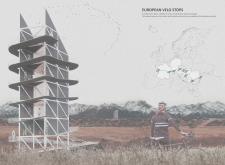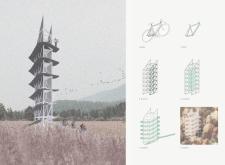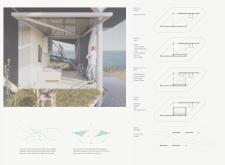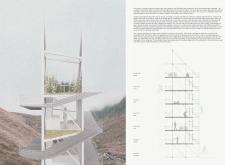5 key facts about this project
The architectural design emphasizes a harmonious relationship with the surrounding landscape, utilizing an elevated structure that minimizes ground disruption. By utilizing vertical space, the project offers a compact footprint while maximizing functionality. The elevation allows for uninterrupted natural flow beneath the structure, which not only preserves ecological integrity but also enriches the views for users within the facility. The forms are angular and intentional, reflecting the dynamism associated with cycling while providing an aesthetically engaging experience.
Functionally, the Velo Stops are equipped with various amenities tailored to the needs of cyclists. The layout incorporates multiple levels designed to cater to different activities. At the ground level, easy access to cycling paths is prioritized, allowing cyclists to transition seamlessly. The intermediate levels are designed as rest areas, equipped with sleeping quarters, communal lounges, and bicycle storage solutions that promote social interaction among users. This encourages a sense of community and shared experience, enhancing the overall journey for cyclists.
In terms of materiality, the project utilizes a carefully curated selection that aligns with its architectural philosophy. Steel forms the primary structural framework, providing the necessary durability and strength. The use of wood adds a warm, inviting element, contributing to both aesthetic appeal and user comfort. Glass elements within the design support transparency, allowing natural light to permeate the spaces and providing visual connections to the outdoor environment. This choice of materials reflects a commitment to sustainability, as they minimize the carbon footprint while enhancing the overall user experience.
One of the standout design approaches of the Velo Stops is its ability to adapt to various geographical contexts while maintaining the core architectural principles. Whether nestled in hilly, flat, or mountainous terrains, the design can be adjusted to blend with the environment seamlessly. This innovative approach to architecture showcases the potential for bike-friendly infrastructure that enhances the travel experience without imposing on the natural landscape.
Furthermore, the architectural design encourages sustainable practices, such as rainwater harvesting and promoting local biodiversity through the integration of green spaces. By elevating the structure, the design fosters a balance between built and natural environments, emphasizing a commitment to ecological responsibility.
In summary, the European Velo Stops project is an embodiment of contemporary architectural thought, merging functionality, sustainability, and community in a cohesive design. The attention to user needs while respecting the surrounding environment highlights the potential of architecture to enhance everyday experiences. For those interested in exploring the nuances of this project, including architectural plans, sections, and design ideas, a detailed presentation awaits to provide deeper insights into this innovative architectural endeavor.


























